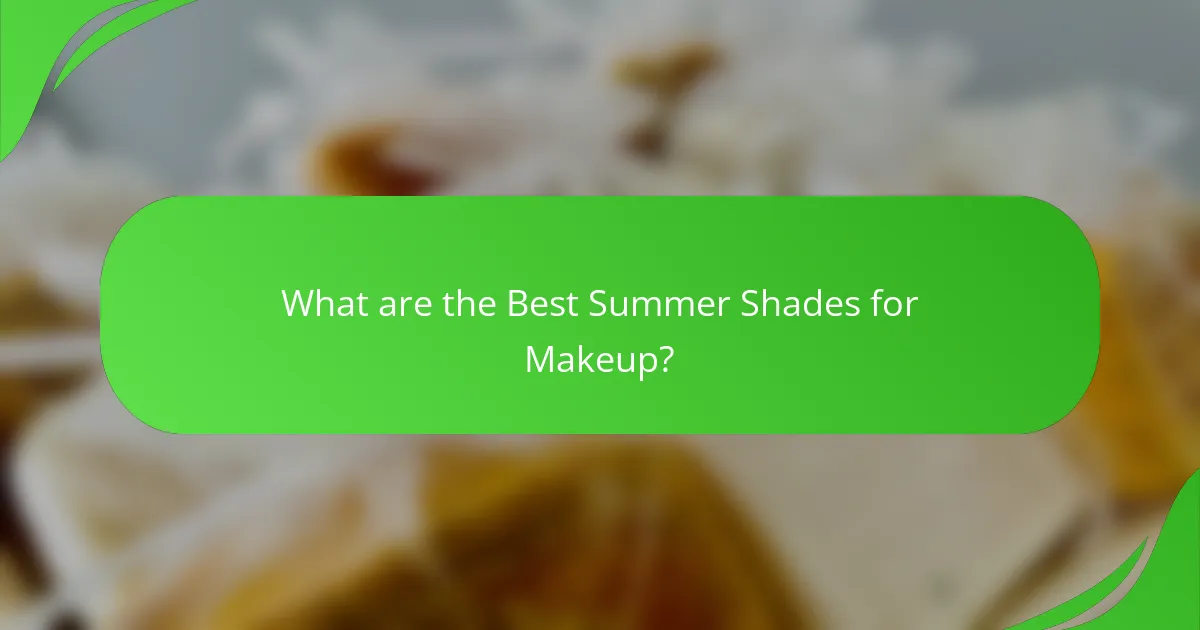Seasonal makeup techniques involve the application of cosmetics tailored to different seasons, taking into account factors such as weather, skin type, and color palettes. Summer makeup emphasizes lightweight formulas and vibrant colors like coral and peach, while winter techniques focus on creamy, hydrating textures and deeper hues to combat dryness. Key summer products often include SPF for sun protection, whereas winter makeup features moisturizing ingredients like hyaluronic acid. This article explores optimal shades and textures for both seasons, providing practical tips for enhancing appearance while adapting to changing environmental conditions.

What are Seasonal Makeup Techniques?
Seasonal makeup techniques are methods of applying cosmetics that vary according to different seasons. These techniques consider factors like weather, skin type, and color palettes. For example, summer techniques often emphasize lightweight formulas and bright colors. In contrast, winter techniques tend to focus on richer textures and deeper hues. Seasonal changes affect skin hydration and texture, influencing makeup choices. During summer, products with SPF are commonly used to protect against sun damage. In winter, moisturizing products help combat dryness. These techniques enhance overall appearance while adapting to seasonal conditions.
How do Seasonal Makeup Techniques vary across different seasons?
Seasonal makeup techniques vary significantly across different seasons. In spring, lighter colors and dewy finishes are popular, reflecting the fresh blooms. Summer emphasizes bronzed skin and waterproof products to withstand heat. Fall introduces richer tones like burgundy and warm neutrals, aligning with autumn foliage. Winter focuses on moisturizing products and bold colors to combat dry skin and darker days. Each season’s techniques adapt to environmental factors and aesthetic preferences, ensuring makeup complements the changing landscape and mood.
What are the key characteristics of summer makeup techniques?
Summer makeup techniques emphasize lightweight formulations and natural finishes. These techniques often utilize tinted moisturizers or BB creams instead of heavy foundations. They focus on enhancing the skin’s natural glow with bronzers and highlighters. Bright, vibrant colors for eyes and lips are common during summer. Waterproof products are preferred to withstand heat and humidity. Minimalism is key, with a focus on a fresh-faced look. Proper sun protection, such as SPF-infused makeup, is essential during this season. These characteristics help create a long-lasting, radiant appearance suitable for warm weather.
What defines winter makeup techniques?
Winter makeup techniques are defined by their focus on hydration, warmth, and longevity. These techniques prioritize moisturizing products to combat dry winter air. Cream-based foundations and hydrating primers are commonly used. Warm color palettes featuring deep reds, plums, and golds are prevalent. The application often includes layering for a more durable finish. Additionally, techniques emphasize a glowing complexion to counteract dullness. Winter makeup also incorporates long-lasting formulas to withstand colder temperatures. This approach ensures makeup remains intact throughout the day.
Why is it important to adapt makeup techniques seasonally?
Adapting makeup techniques seasonally is important for achieving optimal results. Different seasons bring varying weather conditions that affect skin type and texture. For instance, summer heat can cause makeup to melt, necessitating lighter formulas and long-lasting products. In contrast, winter cold can dry out the skin, requiring moisturizing products and cream-based formulas for hydration. Seasonal changes also influence color preferences. Warmer tones are often favored in summer, while cooler shades are popular in winter. Adjusting makeup techniques ensures that products work effectively with these seasonal variations. This practice enhances overall appearance and maintains skin health throughout the year.
How do seasonal changes affect skin and makeup application?
Seasonal changes significantly affect skin and makeup application. In winter, cold weather can lead to dry skin. This dryness necessitates the use of heavier moisturizers and hydrating primers. Makeup application may require cream-based products for a dewy finish.
In contrast, summer heat increases oil production in the skin. This results in the need for lightweight, matte foundations. Makeup may also shift towards waterproof formulas to withstand humidity.
Additionally, seasonal color palettes vary. Warmer tones are favored in summer, while cooler shades dominate in winter. These seasonal adjustments ensure makeup complements the skin’s condition and the overall environment.
What benefits come from using seasonal makeup techniques?
Using seasonal makeup techniques enhances appearance and aligns with current trends. These techniques allow individuals to adapt their makeup to changing weather conditions. For example, lighter formulations suit summer heat, while richer textures benefit winter dryness. Seasonal shades can complement skin tones affected by seasonal changes. Additionally, using seasonal products can improve makeup longevity and performance. Research shows that adapting makeup to seasons can boost confidence and mood. Seasonal techniques also encourage creativity and experimentation with different looks.

What are the Best Summer Shades for Makeup?
The best summer shades for makeup include vibrant and fresh colors. Coral, peach, and pink are popular choices for lips and cheeks. Bright shades of blue and green work well for eyeshadow. Additionally, warm golds and bronzes enhance a sun-kissed glow. These shades complement the bright and sunny atmosphere of summer. According to beauty experts, lighter formulations like tinted moisturizers are preferred in hot weather. This approach ensures comfort and a natural look.
Which colors are trending for summer makeup?
Bright and vibrant colors are trending for summer makeup. Shades like coral, hot pink, and sunny yellow are popular choices. Additionally, pastel hues such as lavender and mint green are also in vogue. These colors reflect the lively and fresh spirit of summer. Many beauty brands are featuring these shades in their collections. Trends indicate a shift towards bold and playful looks. Seasonal fashion also influences these color choices. The warm weather encourages lighter and brighter palettes.
What are the most popular summer lipstick shades?
The most popular summer lipstick shades include vibrant corals, bright pinks, and soft nudes. These colors complement the sunny season and enhance a fresh look. Coral shades provide a lively pop of color, perfect for summer outings. Bright pinks add a playful touch and are favored for their eye-catching appeal. Soft nudes offer a subtle elegance, making them versatile for various occasions. According to beauty industry trends, these shades consistently rank high during summer months. They reflect the season’s lively spirit and are often featured in seasonal makeup collections.
How do summer eyeshadows enhance a summer look?
Summer eyeshadows enhance a summer look by adding vibrant, lively colors that reflect the season’s brightness. These shades often include warm tones like corals, golds, and pastels. Such colors can brighten the complexion and create a fresh, youthful appearance. Additionally, summer eyeshadows typically have a lightweight, blendable formula. This allows for easy application and a natural finish, ideal for warm weather. The use of shimmery or metallic finishes can also capture sunlight, adding a radiant glow. Overall, summer eyeshadows contribute to a cheerful and energetic aesthetic suitable for summer activities.
How can you achieve a fresh summer makeup look?
To achieve a fresh summer makeup look, start with a lightweight foundation or tinted moisturizer. This provides a natural finish and allows your skin to breathe. Use a cream blush for a dewy effect on the cheeks. Apply bronzer to enhance your sun-kissed glow. Choose vibrant eyeshadow shades like coral or pastel tones for a lively appearance. Waterproof mascara is essential to prevent smudging in heat and humidity. Finish with a tinted lip balm or gloss for hydration and color. These products help create a radiant and effortless summer look.
What application techniques work best for summer makeup?
Lightweight formulas work best for summer makeup application. These include tinted moisturizers and lightweight foundations. Applying with a damp sponge provides a natural finish. This technique helps to blend products seamlessly into the skin. Using a setting spray can enhance longevity in hot weather. Cream blushes and bronzers give a dewy look that lasts. For eye makeup, waterproof formulas prevent smudging. Applying products in thin layers allows for buildable coverage without heaviness.
How can you ensure long-lasting summer makeup?
To ensure long-lasting summer makeup, start with a primer. A quality primer creates a smooth base and helps makeup adhere better. Use oil-free and mattifying formulas to control shine. Next, opt for waterproof or long-wear products. These formulations resist sweat and humidity, ensuring makeup stays in place.
Setting powders or sprays are essential for locking in the look. They provide a final layer of protection against the elements. Additionally, consider using cream products instead of powders. Creams blend seamlessly and tend to last longer in warm weather.
Lastly, touch up throughout the day with blotting papers. These absorb excess oil without disturbing your makeup. Following these steps can significantly enhance the durability of your summer makeup.

What are the Ideal Textures for Winter Makeup?
The ideal textures for winter makeup include creamy, hydrating, and luminous formulations. Creamy textures provide moisture, which is essential in cold weather. Hydrating products help combat dryness caused by cold air and indoor heating. Luminous finishes give a healthy glow, countering winter’s dullness. These textures can be found in foundations, blushes, and highlighters. For instance, cream blushes blend seamlessly and add warmth to the complexion. Additionally, hydrating foundations often contain ingredients like hyaluronic acid for extra moisture. Using these textures ensures a fresh and radiant look during winter months.
How do winter textures differ from summer textures?
Winter textures are typically richer and more hydrating compared to summer textures. In winter, skin often becomes dry due to cold weather. As a result, makeup products are formulated to provide moisture and a creamy finish. These products include thicker foundations and hydrating primers. Summer textures, on the other hand, are lighter and more breathable. They often feature matte finishes to control oil and sweat. Summer products include gel-based foundations and lightweight tinted moisturizers. The difference in textures is driven by seasonal skin needs and environmental conditions.
What are the best foundations for winter makeup?
The best foundations for winter makeup are hydrating and moisturizing formulas. These foundations help combat dryness caused by cold weather. Look for products with ingredients like hyaluronic acid and glycerin. They provide hydration while offering coverage. Cream and liquid foundations are often preferred in winter. They tend to have a dewy finish, which looks fresh and radiant. Brands like NARS, Fenty Beauty, and Estée Lauder offer popular winter foundations. Their formulations cater well to dry skin types. Additionally, using a primer can enhance the foundation’s performance in winter conditions.
How can moisturizing products enhance winter makeup?
Moisturizing products enhance winter makeup by providing hydration and creating a smooth base. In winter, skin can become dry and flaky due to cold weather. A well-hydrated face allows makeup to apply more evenly and look fresh. Moisturizers also help in preventing makeup from settling into fine lines. Ingredients like hyaluronic acid can attract moisture and plump the skin. This leads to a dewy finish that is often desired in winter makeup. Studies show that hydrated skin reflects light better, enhancing the overall appearance of makeup. Thus, incorporating moisturizing products is essential for a flawless winter makeup look.
What techniques should be used for winter makeup application?
Winter makeup application techniques include using hydrating products, layering for warmth, and choosing rich colors. Hydrating primers and foundations help combat dry skin. Cream-based products provide a dewy finish and blend easily. Layering products, like foundation and concealer, ensures coverage without heaviness. Rich colors, such as deep reds and plums, complement winter tones. Additionally, setting sprays can help maintain makeup in cold, dry air. These techniques cater to winter’s unique challenges, ensuring a fresh, radiant look.
How can you layer products effectively in winter?
Layer products effectively in winter by starting with a hydrating primer. This creates a smooth base and helps products adhere better. Next, apply a moisturizing foundation to combat dryness. Use a cream blush for a natural flush that blends seamlessly. Follow with a setting powder to lock in moisture without looking cakey. Incorporate a hydrating setting spray to keep the look fresh. Finally, finish with a nourishing lip balm to prevent chapped lips. These steps ensure a radiant and long-lasting winter makeup look.
What are the tips for maintaining hydration while applying winter makeup?
To maintain hydration while applying winter makeup, start with a hydrating primer. A good primer creates a moisture barrier. Choose products that contain ingredients like hyaluronic acid or glycerin. These ingredients attract and retain moisture in the skin.
Next, use a moisturizing foundation. A foundation with added hydration helps prevent dryness. Consider using a setting spray with hydrating properties. This can lock in moisture throughout the day.
Additionally, apply a hydrating lip balm before lipstick. This keeps lips from chapping in cold weather. Finally, drink plenty of water to keep your skin hydrated from within. Research shows that proper hydration supports skin elasticity and overall appearance.
What general tips can enhance seasonal makeup techniques?
To enhance seasonal makeup techniques, focus on adapting color palettes to match the season. Use warm tones for summer and cool tones for winter. Consider the skin’s moisture levels; hydrating products work well in winter, while lightweight formulas suit summer. Adjust application techniques based on temperature; lighter layers in hot weather and heavier coverage in cold can improve longevity. Incorporate seasonal trends, such as dewy finishes in summer and matte looks in winter. Lastly, always set makeup with appropriate powders or sprays to ensure it lasts throughout the day.
How can you customize your makeup routine for seasonal changes?
To customize your makeup routine for seasonal changes, adjust products and techniques based on weather conditions. In summer, use lightweight foundations and waterproof formulas to combat humidity. Opt for bronzers and highlighters to enhance a sun-kissed glow. In winter, switch to cream-based foundations for hydration and add moisturizing primers. Incorporate deeper shades for lips and eyes to complement the season’s mood. Seasonal changes affect skin type and texture, so reassess your skincare routine as well. For example, dry skin in winter may require richer moisturizers. Adapt your makeup application techniques to suit the climate for a flawless look.
Seasonal Makeup Techniques encompass methods of applying cosmetics that adapt to the changing seasons, considering factors such as weather, skin type, and color palettes. The article explores the distinct characteristics of summer and winter makeup techniques, including recommended products and application strategies for each season. Key topics include the importance of lightweight, waterproof formulations for summer, and the use of hydrating, creamy textures for winter. Additionally, it highlights trending colors and provides tips for achieving a fresh look while maintaining skin health throughout seasonal transitions.


